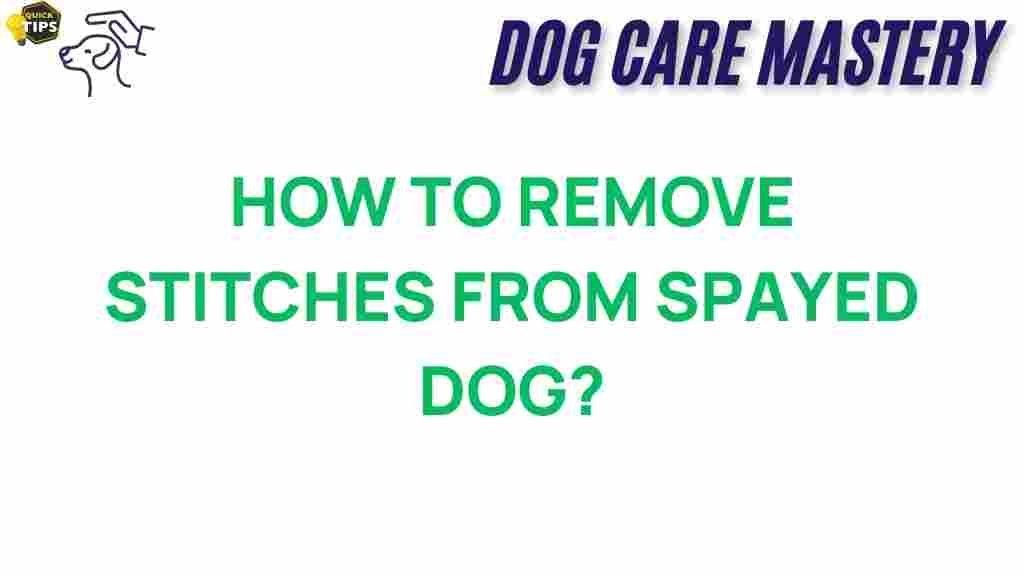As a responsible pet owner, you want the best for your furry friend, and part of that involves understanding how to care for them after procedures like spaying. One key aspect of post-operative care is the removal of stitches. While it may seem intimidating, with the right knowledge and tools, you can safely remove the stitches from your spayed dog at home. In this article, we will guide you through the process step-by-step, provide troubleshooting tips, and ensure you’re well-equipped to handle this important aspect of dog care.
Understanding the Importance of Proper Stitches Removal
Stitches, or sutures, are used during surgeries to hold the skin together as it heals. Removing them at the right time is crucial for your dog’s recovery. If left in too long, stitches can cause infection or other complications. Conversely, removing them too early can disrupt the healing process. Typically, stitches are removed 10 to 14 days after surgery, but it’s essential to follow your veterinarian’s advice regarding your dog’s specific needs.
Tools You Will Need for Stitches Removal
Before you begin the process, gather the following tools:
- Clean, sharp scissors (preferably surgical scissors)
- Tweezers (preferably sterile)
- Antiseptic solution or wipes
- Gauze pads
- Dog treats (for positive reinforcement)
- A helper (optional, but recommended)
Step-by-Step Process for Removing Stitches
Now that you have your tools ready, follow these steps to safely remove the stitches from your spayed dog:
Step 1: Prepare Your Dog
Make sure your dog is calm and comfortable. You may want to take your dog to a quiet area in your home where distractions are minimal. If your dog is anxious, consider using a calming spray or playing soothing music.
Step 2: Clean the Area
Using the antiseptic solution or wipes, gently clean the area around the stitches to minimize the risk of infection. Allow it to dry before proceeding.
Step 3: Examine the Stitches
Look closely at the stitches to assess their condition. Ensure there are no signs of infection, such as redness, swelling, or discharge. If you notice any of these signs, contact your veterinarian before proceeding.
Step 4: Start Removing Stitches
Using the scissors, carefully cut the knot of the stitch. It’s essential to only cut the knot and not the actual thread that goes through the skin. Here’s how to do it:
- Gently lift the stitch with tweezers to expose the knot.
- With the scissors, snip the knot without cutting the thread.
- Once the knot is cut, gently pull the thread out using the tweezers.
- Repeat this for each stitch, ensuring you maintain a calm demeanor to keep your dog relaxed.
Step 5: Clean the Area Again
After all the stitches are removed, clean the area again with antiseptic to prevent any possible infections.
Step 6: Reward Your Dog
Once the process is complete, reward your dog with treats and praise. This positive reinforcement helps create a positive association with the experience, making future procedures less stressful.
Troubleshooting Tips for Stitches Removal
Even with careful preparation, you may encounter some challenges during the stitches removal process. Here are some troubleshooting tips to help you:
Dog is Anxious or Uncooperative
If your dog is anxious, try the following:
- Have a helper hold your dog gently but firmly.
- Use treats to distract and reward your dog during the process.
- Take breaks if your dog becomes too stressed.
Stitches are Difficult to Remove
If the stitches do not come out easily:
- Do not force them. This can cause pain or injury.
- Double-check that you’ve cut the knot correctly.
- If you encounter resistance, consult your veterinarian for assistance.
Signs of Infection
If you notice any signs of infection, such as:
- Redness or swelling around the incision site
- Pus or discharge
- Excessive licking or chewing at the site
Contact your veterinarian immediately for further evaluation and treatment.
When to Seek Professional Help
While many pet owners can successfully remove stitches at home, there are times when it’s best to consult a veterinarian:
- If you’re unsure about the process or feel uncomfortable.
- If your dog exhibits severe anxiety or stress.
- If you notice any complications such as infection or excessive bleeding.
Your veterinarian can provide professional assistance and ensure your dog’s healing process goes smoothly.
Conclusion: The Importance of Post-Surgical Care in Dog Care
Removing stitches from your spayed dog can be a straightforward process when done correctly. By following these steps and being attentive to your dog’s needs, you can ensure a smooth recovery. Remember, proper dog care extends beyond just the removal of stitches—it includes monitoring for signs of infection, maintaining cleanliness, and providing your dog with plenty of love and support during their recovery.
If you have any concerns or questions, don’t hesitate to reach out to your veterinarian for guidance. Your dog’s health and well-being are paramount, and together, you can navigate the recovery process with confidence.
For more information on dog care, check out this helpful resource on post-operative care for pets.
For professional veterinary services, consider visiting local veterinarians in your area who can provide further assistance and support.
This article is in the category Health and created by dogcaremastery Team
